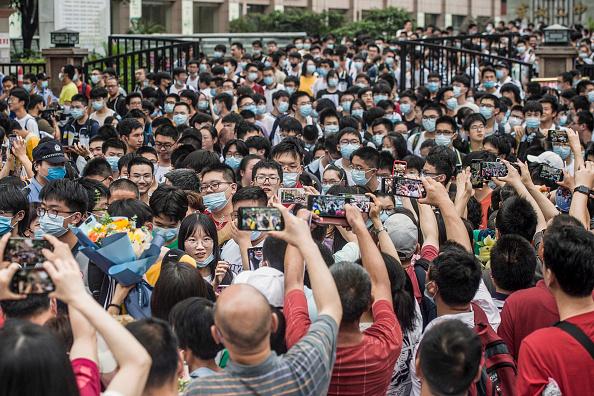As this year comes to an end, Beijing will be both uncertain and concerned about what is to come in 2022.
China’s economy relies on three strong economic driving forces: domestic consumption, foreign trade, and foreign direct investment. But these economic engines are losing or have lost their power due to Beijing’s mishandling of both domestic and international situations.
Purging of Private Sectors Dooms Economy
The first economic driving force—domestic spending—has lost its driving momentum due to the Chinese Communist Party (CCP) using political methods to deal with economic issues.The regime’s methods, remind me of a Chinese fable that warns people not to deal with a situation through the use of force. According to the fable, a self-declared doctor says he is good at curing hunchbacks. When a patient came to him seeking to get better, he put a splint on both the patient’s chest and the back. He would then flatten the patient on the ground, and then stomp on the patient violently. The patient ends up with a flat back but a fractured spine.
The economic situation in China is just like that patient in the fable. When China’s economy foresees a slide, the CCP cracks down on the private sector to snap money from wealthy entrepreneurs, causing a chain reaction affecting related industries and creating more unemployment. With such a pattern, the Chinese economy will only decline further.
- Real estate and property: The industry as a whole is experiencing a desperate debt crisis.
- Education and training: The impact of the “double reduction” policy imposed by the regime is yet to be decided, as this industry represents a market value of about $471 billion, at current exchange rates. The “double reduction” policy is literally “reducing the students’ burdens of homework and off-campus training” in English.
- Aviation and airports: Down by 135 percent as compared to the same period last year. The pandemic and fuel prices both triggered the downturn.
- Tourism: Down by 84 percent as compared to the same period last year largely blamed on the pandemic.
- Shopping malls and supermarkets: Down by 60 percent as compared to the same period last year. The fall comes as a result of multiple new sales modes through e-commerce.

Increased Unemployment Adds to Shrinking Domestic Consumption
The industries’ shrinking operating profits have brought about higher unemployment.The regime’s state council disclosed that the surveyed urban unemployment rate was 4.9 percent in September, 0.5 percentage points lower than the same period last year. However, the debt defaults of Chinese property giants, the crash of the private education and training sector, and the tighter control over the big e-commerce companies have led to an increase of at least 10 million unemployed people in the industries.
The actual number could be higher due to the CCP’s censorship of information.
Nonetheless, with plunging industrial profits and increasing unemployment, Chinese people are seeing a reduction in their income, which naturally cuts their spending.
Uncertainty in Foreign Trade
The second economic driving force for China is foreign trade, which the regime relies on heavily for economic growth.According to the state’s National Bureau of Statistics, the total value of imports and exports of goods in the first three quarters of 2021 reached $4,447 billion, which accounted for about 29 percent of China’s GDP for the year. Last year’s total import and export value was $5,048 billion, taking up about 30 percent of China’s GDP.
The figures remain more or less unchanged from its share in GDP. However, the European Union and the United States, the two major global economies, are currently being hit hard by the pandemic, likely changing China’s import and export data.
On top of that, the CCP’s cover-up of the origin of the new coronavirus has deteriorated its relationship with these two economies, which are among the top four trading partners with China. The United States, moreover, is the main source of China’s foreign trade surplus.

Another significant factor impacting China’s foreign trade is the soaring sea freight costs during the pandemic. With an uncertain global economic outlook, the CCP has no idea whether it can maintain the momentum of its foreign trade in 2022.
Less Attractive to Foreign Direct Investment
The third driving force of China’s economy is foreign direct investment (FDI) of which the Chinese regime had been very confident in attracting.According to the regime’s Ministry of Commerce in Nov. 2021, “China’s actual use of foreign investment during the first 10 months amounted to $148 billion, up 18 percent year-on-year.”
However, I would like to use one word, “uncertainty,” to describe the FDI situation in 2021.
According to Kearney, the United States still ranks first—for the ninth year in a row—followed by Canada, Germany, the United Kingdom, Japan, France, Australia, Italy, Spain, and Switzerland, as the top 10 countries on this year’s index. Spain replaced China in the top 10 this year, which is “likely a reflection of the continued preference for advanced economies,” the index stated.
The index further pointed out that, besides investors’ preferences for developed economies, other factors that have led to China moving down in the list are—China’s declining demographic dividend, manufacturers moving production to home markets due to cost of transport and accelerated automation, and concerns over “financial, reputational, and societal costs associated with data breaches” due to “China’s stringent data protection rule.”
With the domestic private sector clamped down upon by the regime and new FDI gradually losing interest in the China market, the Chinese regime seems to have only one option left—printing money to trigger domestic investment. What makes this last option very questionable is that, amid the economic downturn, the regime will find it difficult to find proper investment projects.
US-China Tensions
There’s a fourth pressure on China’s economy that the CCP should be worried about—its deteriorating relationship with the United States.As Kearney index has noted, China’s falling out of the top 10 is also impacted “by US–China trade tensions, tariffs, and a more general corporate rethink of international supply chains.”
As the top global economy, the United States should be China’s most important economic partner. However, the CCP has damaged U.S.–China relationships with its increasing international assertiveness and wolf warrior diplomacy.
Given that President Joe Biden earlier had a friendly attitude towards China, Beijing did not expect his administration to be as wary as they currently are despite this shift being largely due to the CCP itself.





